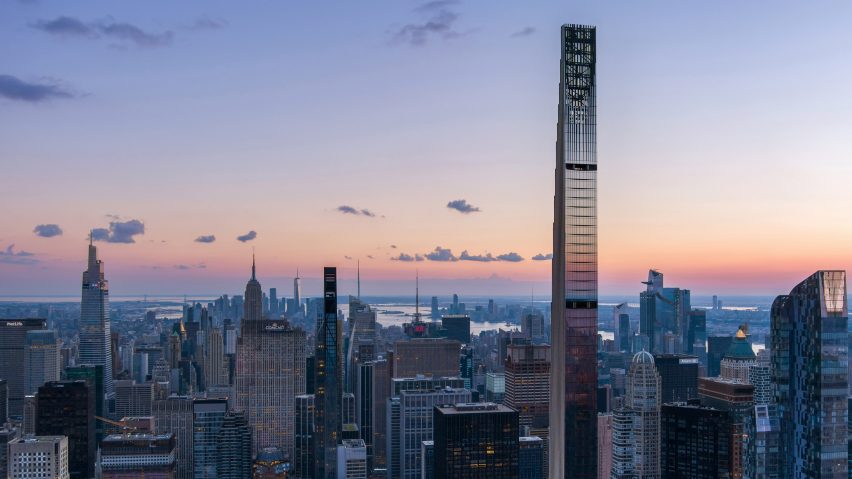Following the world's skinniest skyscraper opening in New York, we round up seven super-skinny skyscrapers that have changed the city's skyline.
Super-skinny skyscrapers, or pencil towers, have begun rising in New York City over the past decade with SHoP Architects' 111 West 57th Street recently becoming the skinniest skyscraper in the world.
Although there is no official ratio to determine whether a skyscraper can be called super-skinny, they are generally considered to be at least 10 times as high as the width at its narrowest point.
With a highly competitive real estate market and a demand for luxury condominiums in New York City driving demand, advances in concrete and steel, as well as the use of weights to counteract the effects of the wind, have made these constructions possible.
Here are seven super-skinny towers that are redrawing the city's skyline:
111 West 57th Street by SHoP Architects (2022)
Completed last month, 111 West 57th is the skinniest skyscraper in the world with a staggering ratio of 24:1.
The SHoP Architects-designed luxury tower, which tapers to a pencil-like top, has only one condominium per floor. Situated in an area known as Billionaire's Row, it faces Central Park to the north and Lower Manhattan to the south.
Construction of the tower began in 2014, but stalled in 2017 due to financial difficulties. Close to completion, the tower came under some criticism as ice fell from the upper reaches to the street, causing injuries and closures.
Central Park Tower by Adrian Smith + Gordon Gill (2019)
At 1,550 feet (472 metres) tall, Central Park Tower is the tallest residential building in the world.
The building, which has a ratio of 18:1, reached its full height in 2019 and opened to residents in 2021.
Chicago-based architecture studio Adrian Smith + Gordon Gill also designed Jeddah Tower in Saudia Arabia, which, if completed, will become the tallest skyscraper in the world.
Completed in 2019, this tower, also known as the MoMa Tower because of its proximity to the New York museum, was designed by French architect Jean Nouvel.
The 77-storey building, which is 1,050 feet (320 metres) tall, is the 11th highest building in the city and has a height to width ratio of 12:1.
At the time of its opening, the Pritzer Architecture Prize-winning architect said "[a]rchitecture is art, and architecture is born from its situation, from its context."
Selene by Foster + Partners (2019)
The 63-storey skyscraper next to the Mies van der Rohe-designed Seagram Building in Midtown Manhattan was designed by British architecture firm Foster + Partners to contrast its neighbour.
"In contrast to Seagram's dark bronze, our tower will have a pure white, undulating skin. Its proportions are almost impossibly slim and the views will be just incredible," said Foster + Partners founder Norman Foster.
Formerly named 100 East 53rd Street, the residential tower with 94 units was completed in 2019 and has a height-to-width ratio of approximately 15:1.
Madison Square Park by Kohn Pedersen Fox (2017)
The tallest building in the Flatiron District, Madison Square Park is 777 feet (237 metres) tall.
The 65-storey, KPF-designed skyscraper is very narrow at the base, where the ratio is 13:1, but slopes out slightly so that the midsection is wider than the bottom.
56 Leonard by Herzog de Meuron (2017)
Designed by Herzog de Meuron, the 56 Leonard skyscraper is located in the Lower Manhattan neighbourhood of Tribeca.
The 60-storey is known locally as the "Jenga Tower" because of the jagged, stacked nature of its facade. At its thinnest, it has a ratio of 10.5:1, just qualifying as a super-skinny skyscraper.
432 Park Avenue by Rafael Viñoly Architects (2015)
This 1,286-foot (392.1-metre) skyscraper designed by the studio of Uruguayan architect Rafael Viñoly has 85 storeys and a uniform envelope and was an early example of engineering a super-skinny skyscraper, with its height to width ratio of 15:1.
After its completion, residents of 432 Park Avenue were plagued by floods and the swaying from the wind, making the tower somewhat emblematic of problems associated with super-skinny supertalls, leading the architect to apologise for "screw-ups".

